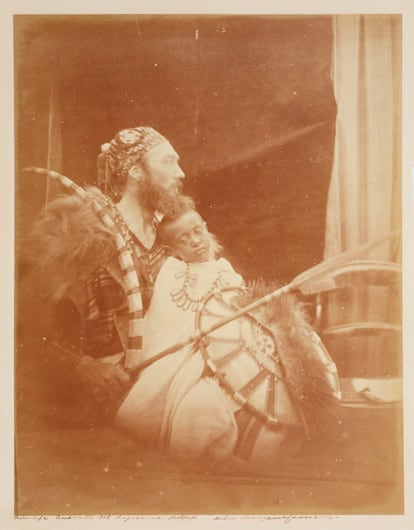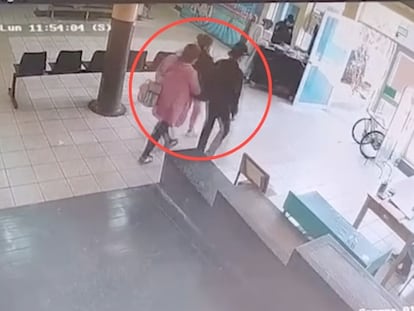UK returns a lock of Prince Alemayehu’s hair to Ethiopia 140 years after he was kidnapped
The son of Emperor Tewodros II was captured in 1868 at the age of seven by a British expedition. The royal house has so far refused to return his remains, which lie in Windsor Castle

British society has sometimes been quicker than its government institutions to repair the damage of its colonial footprint in the world, if only with small gestures that are more symbolic than anything else. Last Thursday, in a low-key ceremony in London, Ethiopia’s ambassador to the United Kingdom, Teferi Melesse, received a lock of hair from Ethiopia’s Prince Alemayehu. The young boy was taken from his homeland in 1868 when he was seven years old and buried aged 18 in St. George’s Chapel at Windsor Castle.
His relatives, descendants of Emperor Tewodros II (negus negusti, or emperor of Abyssinia, in the Amharic language), and the Ethiopian government itself, have repeatedly demanded Alemayehu’s return. Buckingham Palace has so far resisted calls to repatriate his remains, arguing that it is not possible to do so “without disturbing the resting place of a substantial number of others in the vicinity.”
The hair had been in the possession of Leoni Turner, a descendant of Captain Tristam Speedy, one of the leaders of the assault on the fortress of Magdala in 1868, under the command of Robert Napier, an officer of the army of the British Raj, the colonial government of the British crown in the Indian subcontinent. Through the Scheherazade Foundation, which is dedicated to building bridges between cultures, both the lock of hair and much of the plunder from Magdala have been returned to the Ethiopian government. Turner herself was present at the ceremony to hand over the lock of hair.
“The restitution of Ethiopian artefacts looted by the 1868 British expedition to Magdala is important for restorative justice and an excellent way to build better relations and collaborations between British and Ethiopian institutions,” Alula Pankhurst, a member of the National Commission for the Restoration of Ethiopia’s Legacy, told the BBC. But he also made it clear that this is, in his view, a first step.
The kidnapping of the prince
In 1868, Emperor Tewodros II, irritated by Queen Victoria’s lack of response to a letter suggesting an alliance between the two empires, as well as a request for ammunition, armaments, and military experts, took several European missionaries and diplomats hostage in the city of Magdala, among them the British consul. “What happened next can be described as a rain of fire, and one of the greatest orgies of plunder and robbery carried out in the name of the British Empire,” Ethiopian-American writer Maaza Mengiste recounted several years ago.
The story goes that Emperor Tewodros took his own amid the hundreds killed by the British Indian Army at the Battle of Magdala. To ensure their safety on the return journey, the expedition took with Empress Tiruwork Wube, Tewodros’ wife, and their son, Prince Alemayehu, who was then seven years old. The empress died during journey. When Alemayehu reached England, Queen Victoria became fond of the young prince and his melancholic expression — which never left him — when she met him on the Isle of Wight, where she would often go to rest. She agreed to leave Alemayehu, the first child kidnapped by the British Empire, in the hands of Captain Speedy, a strange man who always dressed in oriental clothes and became accustomed to sleeping in the same bed as the prince. After Speedy took the boy with him on a trip halfway around the world, Buckingham Palace decided that he needed a formal education.
Alemayehu was sent to the private Rugby School and from there to the Royal Military Academy at Sandhurst. In both institutions he suffered bullying and was an unhappy child. When he turned 18 and lost his royal maintenance, Speedy decided to leave him in the care of Dr. Arthur Ransome, in the city of Leeds. He died soon after of pleurisy, convinced that someone had poisoned him and still pining for his native Ethiopia. “Much pained and shocked to have learned, through a telegram, of the death this very morning of good Alemayehu,” Queen Victoria wrote in her diary. “It is so sad! So alone, in a strange country, without a single relative [...] His life was not a happy one. Full of difficulties of all kinds. So sensitive, always thinking that people were staring at him because of the color of his skin. We are all very sad,” wrote the monarch.
Queen Victoria decided to bury Alemayehu in St. George’s Chapel at Windsor Castle, not in the royal crypt where the remains of Henry VIII and now Elizabeth II rest, but in the catacombs adjacent to the chapel. “A bronze plaque in the central nave of St. George’s contains the words written by Queen Victoria herself, ‘I was a stranger and ye took me in.’ But Alamayehu’s body rests in the brick crypt outside the chapel. He was not welcomed ‘inside,’” Lemn Sissay, a British author and broadcaster of Ethiopian origin, has denounced.
In March 2019, the United Kingdom presented a lock of Emperor Tewodros II’s hair to an Ethiopian government delegation at the National Army Museum in London.
Sign up for our weekly newsletter to get more English-language news coverage from EL PAÍS USA Edition
Tu suscripción se está usando en otro dispositivo
¿Quieres añadir otro usuario a tu suscripción?
Si continúas leyendo en este dispositivo, no se podrá leer en el otro.
FlechaTu suscripción se está usando en otro dispositivo y solo puedes acceder a EL PAÍS desde un dispositivo a la vez.
Si quieres compartir tu cuenta, cambia tu suscripción a la modalidad Premium, así podrás añadir otro usuario. Cada uno accederá con su propia cuenta de email, lo que os permitirá personalizar vuestra experiencia en EL PAÍS.
¿Tienes una suscripción de empresa? Accede aquí para contratar más cuentas.
En el caso de no saber quién está usando tu cuenta, te recomendamos cambiar tu contraseña aquí.
Si decides continuar compartiendo tu cuenta, este mensaje se mostrará en tu dispositivo y en el de la otra persona que está usando tu cuenta de forma indefinida, afectando a tu experiencia de lectura. Puedes consultar aquí los términos y condiciones de la suscripción digital.
More information
Archived In
Últimas noticias
Welcome to the post-religion era: The idea of Christianity as the absolute truth has become obsolete
‘I thought you would like it’: The risky sexual practice popularized by TV shows and TikTok
The digitalization of tourism: ‘They promise experiences and gave us the worst possible one’
Mexican peso defies uncertainty with forecasts of a new period of stability in 2026
Most viewed
- Sinaloa Cartel war is taking its toll on Los Chapitos
- Oona Chaplin: ‘I told James Cameron that I was living in a treehouse and starting a permaculture project with a friend’
- Reinhard Genzel, Nobel laureate in physics: ‘One-minute videos will never give you the truth’
- Why the price of coffee has skyrocketed: from Brazilian plantations to specialty coffee houses
- Silver prices are going crazy: This is what’s fueling the rally











































